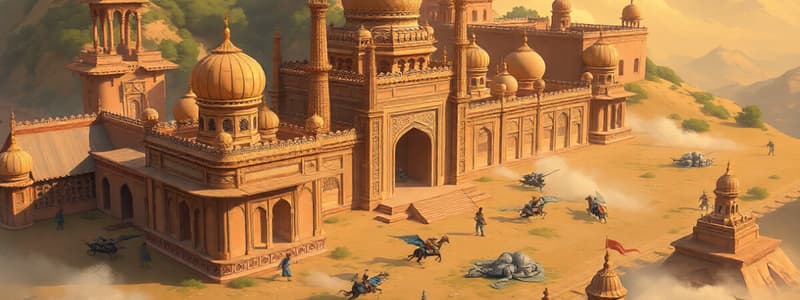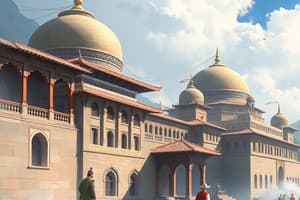Podcast
Questions and Answers
What was a significant military advancement that aided land-based empires' expansion from 1450 to 1750?
What was a significant military advancement that aided land-based empires' expansion from 1450 to 1750?
- Horse-drawn artillery
- Longbow innovations
- Naval superiority
- Gunpowder technology (correct)
Which statement accurately describes a method used by rulers to legitimize their authority?
Which statement accurately describes a method used by rulers to legitimize their authority?
- Adopting democratic principles
- Employing the concept of Divine Right (correct)
- Promoting secularism
- Encouraging citizen uprisings
What characteristic set the Safavid Empire apart from the Ottoman Empire?
What characteristic set the Safavid Empire apart from the Ottoman Empire?
- Employment of slave soldiers
- Emphasis on Sunni Islam
- Differing religious practices (correct)
- Use of tax farming
Which empire is known for its significant religious freedoms under the leadership of Akbar?
Which empire is known for its significant religious freedoms under the leadership of Akbar?
Which administrative system utilized by land-based empires involved employing local tax collectors?
Which administrative system utilized by land-based empires involved employing local tax collectors?
What was a primary reason for the decline of nomadic empires during this period?
What was a primary reason for the decline of nomadic empires during this period?
Which of the following was a key factor behind European maritime empires' success?
Which of the following was a key factor behind European maritime empires' success?
What was a common practice among both the Inca and Aztec Empires?
What was a common practice among both the Inca and Aztec Empires?
What was the primary purpose of the encomienda and hacienda systems in the Spanish Empire?
What was the primary purpose of the encomienda and hacienda systems in the Spanish Empire?
Which empire was instrumental in establishing a colony in Brazil?
Which empire was instrumental in establishing a colony in Brazil?
What significant social outcome resulted from the Atlantic Slave Trade in Africa?
What significant social outcome resulted from the Atlantic Slave Trade in Africa?
Which innovation was introduced by the Dutch Empire that transformed trade practices?
Which innovation was introduced by the Dutch Empire that transformed trade practices?
What was a major consequence of the Treaty of Tordesillas?
What was a major consequence of the Treaty of Tordesillas?
How did the Protestant Reformation challenge the Catholic Church?
How did the Protestant Reformation challenge the Catholic Church?
Which agricultural exchange was part of the Columbian Exchange from the Old World to the New World?
Which agricultural exchange was part of the Columbian Exchange from the Old World to the New World?
What societal structure was established through the Casta System in Latin America?
What societal structure was established through the Casta System in Latin America?
Flashcards
Land-Based Empires (1450-1750)
Land-Based Empires (1450-1750)
Empires that expanded and controlled territories primarily through land-based routes and military power, often relying on gunpowder technology and complex political structures.
Gunpowder Technology
Gunpowder Technology
Improved weaponry (e.g., cannons, firearms) that made battles more decisive and facilitated empire expansion.
Ottoman Empire
Ottoman Empire
A large, powerful empire that controlled parts of Europe, Asia, and Africa through military conquest and administrative strategies like the Devshirme.
Devshirme
Devshirme
Signup and view all the flashcards
Safavid Empire
Safavid Empire
Signup and view all the flashcards
Mughal Empire
Mughal Empire
Signup and view all the flashcards
Qing Dynasty
Qing Dynasty
Signup and view all the flashcards
Tokugawa Shogunate
Tokugawa Shogunate
Signup and view all the flashcards
Inca Empire
Inca Empire
Signup and view all the flashcards
Aztec Empire
Aztec Empire
Signup and view all the flashcards
Bureaucracy
Bureaucracy
Signup and view all the flashcards
Divine Right of Kings
Divine Right of Kings
Signup and view all the flashcards
Mandate of Heaven
Mandate of Heaven
Signup and view all the flashcards
Encomienda System
Encomienda System
Signup and view all the flashcards
Hacienda System
Hacienda System
Signup and view all the flashcards
Treaty of Tordesillas
Treaty of Tordesillas
Signup and view all the flashcards
Trading Post Empires
Trading Post Empires
Signup and view all the flashcards
Columbian Exchange
Columbian Exchange
Signup and view all the flashcards
Atlantic Slave Trade
Atlantic Slave Trade
Signup and view all the flashcards
Mercantilism
Mercantilism
Signup and view all the flashcards
Joint-Stock Companies
Joint-Stock Companies
Signup and view all the flashcards
Triangular Trade
Triangular Trade
Signup and view all the flashcards
Protestant Reformation
Protestant Reformation
Signup and view all the flashcards
Casta System
Casta System
Signup and view all the flashcards
Millet System
Millet System
Signup and view all the flashcards
Mughal Rajput System
Mughal Rajput System
Signup and view all the flashcards
Renaissance
Renaissance
Signup and view all the flashcards
Study Notes
Land-Based Empires (1450-1750)
- Expansion and Control: Gunpowder technology improved warfare, aiding empires' expansion.
- Political Structure: Empires maintained controls, often using religious justification (e.g., Divine Right, Mandate of Heaven).
- Religious Influence: Major religions spread, supporting rulers' authority.
- Decline of Nomadic Empires: Opened opportunities for land-based empires to grow.
- Ottoman Empire: Conquered Constantinople (1453), consolidated power through caliphate title, Devshirme system, and tax farming. Often clashed with Safavids.
- Safavid Empire: Emphasized loyalty through Ghulams (slave soldiers). Religious differences led to conflicts with Ottomans.
- Mughal Empire: Expanded religious freedoms under Akbar, used Zamindars for taxation, and built the Taj Mahal. Declined after Aurangzeb's death (1707).
- Qing Dynasty (China): Established by Manchus (1644), reintroduced civil service exams. Restricted Han Chinese, used art for legitimization.
- Tokugawa Shogunate (Japan): Unified Japan (1600). Initially open to trade, then restricted foreign influence.
- Inca Empire: Famous for Mita labor, extensive roads, and human sacrifices. Conquered by Spain after Atahualpa's capture.
- Aztec Empire: Used a tribute system and practiced human sacrifices. Fallen to Spanish, Mexico City built on the ruins.
Administrative Systems
- Bureaucracies: Used by rulers, like Mughal Zamindars, Chinese civil service.
- Divine Right of Kings (Europe)/Mandate of Heaven (China): Justified rule as divinely sanctioned.
- Military Elites: Janissaries (Ottoman Empire), Samurai (Japan).
Maritime Empires (Sea-Based Empires)
- Key Characteristics: European dominance in exploration and trade routes to Asia. Relied on colonies, trade routes, and overseas wealth.
- Technological Advancements: Ships (Caravel, Fluyt, Carrack) and navigational tools (astrolabe, magnetic compass, lateen sail).
- Spanish Empire: Encomienda and Hacienda systems for indigenous labor. Treaty of Tordesillas divided Americas.
- Portuguese Empire: Pioneered trading posts in Africa, established Brazil colony.
- British Empire: Won Seven Years' War, gained control of Canada and India.
- French Empire: Suffered from economic instability.
- Dutch Empire: Trading posts in Southeast Asia, introduced stock exchange and joint-stock companies.
Transoceanic Interconnections
- The Columbian Exchange: Biological transfer between Old and New Worlds.
- To Americas: Horses, pigs, wheat, smallpox.
- To Afro-Eurasia: Corn, potatoes, cacao, tomatoes.
- Diseases: Smallpox devastated indigenous populations (up to 90%).
Labor Systems
- Atlantic Slave Trade: Driven by demand for cash crops. Middle Passage transported enslaved people.
- Demographic Impacts: Polygamy in Africa due to demographic imbalance.
- Social Hierarchy: Racial caste systems in Latin America (e.g., Peninsulares, Criollos).
- Indentured Servitude: Workers bound to labor for a set period.
Trade and Economic Systems
- Mercantilism: European economic ideology; believed wealth was finite, driving colonial expansion.
- Joint-Stock Companies: Shared financial risks and profits (British and Dutch East India Companies).
- Triangular Trade: Connected Europe, Africa, and the Americas; intensified violence in Africa and fueled European economic growth.
Socio-Political and Religious Changes
- Protestant Reformation (1517): Martin Luther's 95 Theses challenged the Catholic Church.
- Social Hierarchies:
- Casta System (Latin America): Hierarchical social order based on race and birthplace.
- Ottoman Millet System: Religious communities self-governed.
- Mughal Rajput System: Integrated Hindu rulers into administration.
- Renaissance and Enlightenment: Renaissance, scientific revolution, and enlightenment fostered religious tolerance in places like the Netherlands.
Studying That Suits You
Use AI to generate personalized quizzes and flashcards to suit your learning preferences.




